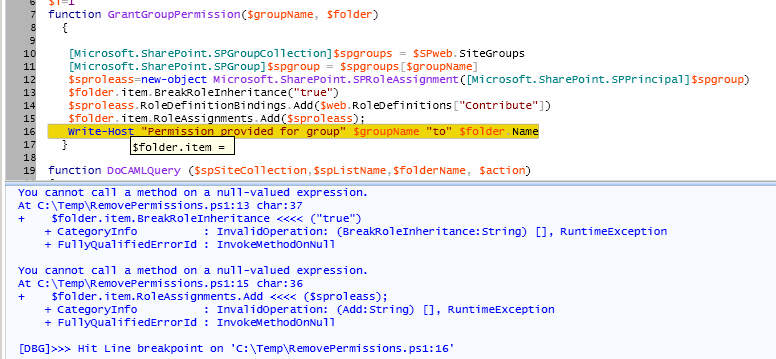Set SharePoint permission on a folder using SPQuery \ CAML
I need to set permissions on a lot of SharePoint folders in a document library but I don't want to have to spin through all folders to find the specific one each time. I have to set permissions on about 1000 folders and have an XML document where I'm getting the folders and their permissions from.
I have the script about 90% written using a CAML query to get the specific folder. (This works fine and returns the specific folder I'm looking for)
However, when I try to set the $currentFolder, it is an SPFolder instead of SPItem.
I've attached 2 files.
One that works when I explicitly give it a folder name.
The second is my script that I'm trying to use CAML to get the folder name
I'm hoping someone here will be able to help figure this out.
WorkingAddPermissions.txt
SetPermissions.txt
I have the script about 90% written using a CAML query to get the specific folder. (This works fine and returns the specific folder I'm looking for)
$spQuery = New-Object Microsoft.SharePoint.SPQuery
$spQuery.Query = "<OrderBy>
<FieldRef Name=BaseName Ascending=TRUE></FieldRef>
</OrderBy>
<Where>
<And>
<Eq><FieldRef Name=ContentType/><Value Type=Text>Folder</Value></Eq>
<Eq><FieldRef Name=BaseName/><Value Type=Text>$folderName</Value></Eq>
</And>
</Where>"
$spQuery.ViewAttributes = "Scope=RecursiveAll"
$spListItems = $spList.GetItems($spQuery)
However, when I try to set the $currentFolder, it is an SPFolder instead of SPItem.
foreach ($spListItem in $spListItems)
{
$currentItem = $spListItem.Name
$folderName = $spListItem.Folder.URL
$folderName = $folderName.Replace($currentItem,"")
$RelativeFolderURL = $spListItem.URL
$currentFolder =$SPWeb.GetFolder($RelativeFolderURL)
GrantGroupPermission $currentFolder
} function GrantGroupPermission($groupName)
{
[Microsoft.SharePoint.SPGroupCollection]$spgroups = $web.SiteGroups
[Microsoft.SharePoint.SPGroup]$spgroup = $spgroups[$groupName]
$sproleass=new-object Microsoft.SharePoint.SPRoleAssignment([Microsoft.SharePoint.SPPrincipal]$spgroup)
[b][u]#The Next Line Breaks[/u][/b]
$folder.BreakRoleInheritance("true")
$sproleass.RoleDefinitionBindings.Add($web.RoleDefinitions["Contribute"])
[b][u]#This Line Doesn't Work Either[/u][/b]
$folder.RoleAssignments.Add($sproleass);
Write-Host "Permission provided for group ", $groupName
}I've attached 2 files.
One that works when I explicitly give it a folder name.
The second is my script that I'm trying to use CAML to get the folder name
I'm hoping someone here will be able to help figure this out.
WorkingAddPermissions.txt
SetPermissions.txt
ASKER
Hi,
which SharePoint version and edition?
Thanks.
Rainer
which SharePoint version and edition?
Thanks.
Rainer
ASKER
SP 2010 Enterprise
ASKER CERTIFIED SOLUTION
membership
This solution is only available to members.
To access this solution, you must be a member of Experts Exchange.
ASKER
I think that was it! I was casting it to an item instead of letting the object cast itself. I'm going to run through a couple more to verify but I think that was it.
FolderObject.gif
FolderObject.gif
ASKER
Colly, you rock! That was exactly it.
Do you know what the logic is behind why this fails? In normal programming, you can cast a string as an integer to use it in a calculation. Any insight as to why this didn't work would be appreciated.
Do you know what the logic is behind why this fails? In normal programming, you can cast a string as an integer to use it in a calculation. Any insight as to why this didn't work would be appreciated.
It's because you are casting an object to another type that does not allow it (probably because it is incompatible) and this results in a null object.
These articles will probably explain it better than I can:
http://www.blackwasp.co.uk/CSharpAs.aspx
http://www.codeproject.com/Articles/447634/A-Beginners-Tutorial-Type-Casting-and-Type-Convers
http://www.codeproject.com/Articles/5044/Cheat-Sheet-Casting-in-VB-NET-and-C
These articles will probably explain it better than I can:
http://www.blackwasp.co.uk/CSharpAs.aspx
http://www.codeproject.com/Articles/447634/A-Beginners-Tutorial-Type-Casting-and-Type-Convers
http://www.codeproject.com/Articles/5044/Cheat-Sheet-Casting-in-VB-NET-and-C


folder.Item.BreakRoleInher
.item will get you the SPListItem of the folder.